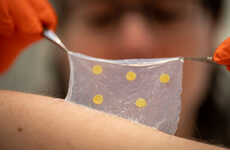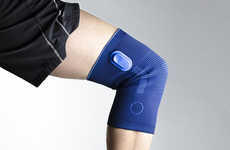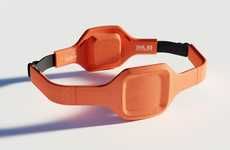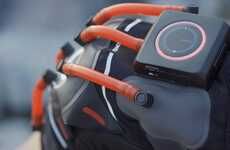
Bruise is a Smart Suit to Visualize Injury in Disabled Athletes
Alyson Wyers — December 3, 2014 — Lifestyle
References: teambruise & psfk
This injury detection suit was created with disabled athletes in mind. Designed by a team of students at the Royal College of Art, Bruise works instantaneously by changing color on impact. Dan Garrett, Elena Dieckmann, Lucy Jung and Ming Kong hope their smart suit enables quicker and more efficient injury treatment.
The injury detection suit is made out of a recyclable pressure-sensitive film that shows how severely the wearer is hurt. Inspired by Paralympic athletes, the design team notes how they often struggle diagnosing injuries with little or no sensation. Made out of a sweat-wicking and stretchy material, Bruise has mesh fabric inserts as well as breathable, ergonomic seams that allow for free movement. Areas deemed high risk have disposable film inserts.
The injury detection suit is made out of a recyclable pressure-sensitive film that shows how severely the wearer is hurt. Inspired by Paralympic athletes, the design team notes how they often struggle diagnosing injuries with little or no sensation. Made out of a sweat-wicking and stretchy material, Bruise has mesh fabric inserts as well as breathable, ergonomic seams that allow for free movement. Areas deemed high risk have disposable film inserts.
Trend Themes
1. Smart Sports Gear - The development of smart sports gear, such as injury detection suits, is disrupting the sports industry by enabling quicker and more efficient injury treatment.
2. Sustainable Materials - The use of recyclable and sustainable materials in injury detection suits is disrupting the fashion industry by promoting sustainability and reducing waste.
3. Assistive Technology - The growth of assistive technology is disrupting the healthcare industry by improving the diagnosis and treatment of injuries among athletes and individuals with disabilities.
Industry Implications
1. Sports Equipment - The sports equipment industry can innovate by incorporating smart technology into their products to improve athlete safety and performance.
2. Fashion Design - Fashion designers can disrupt the fashion industry by using sustainable and recyclable materials in their designs to promote sustainability and reduce waste.
3. Healthcare - The healthcare industry can benefit from disruptive innovations in assistive technology, such as the injury detection suit, which can improve diagnosis and treatment of injuries among athletes and individuals with disabilities.
2.7
Score
Popularity
Activity
Freshness























